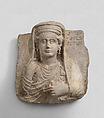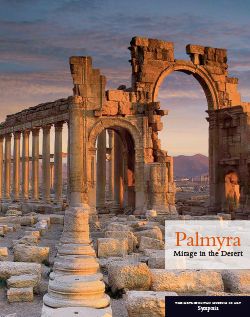Funerary relief
Not on view
Inscription:
1 ‘Alayyat,
2 daughter of
3 Zabdibol.
Transliteration:
1 ʿlyt
2 brt
3 zbdbwl
This relief is a type of funerary monument characteristic of the prosperous caravan city of Palmyra during the first three centuries A.D. Reliefs with a representation of the deceased and a short identifying inscription were used to seal burial niches in elaborately decorated communal tombs; those with a half-length or bust format became prevalent sometime after A.D. 65.
The relief depicts the upper body of a woman dressed in a draped garment, pinned at the left shoulder with an elaborate brooch, who faces directly towards the viewer. Her hair is gathered up at the temples and covered by a turban-like headdress, worn over a richly patterned diadem that covers her forehead. Pendant earrings in the shape of dumbbells, perhaps representing two pearls or beads connected by a vertical rod, hang from her earlobes; the lower ball of each earring is still connected to the stone at either side, to protect this delicately carved detail from breakage. She wears a long veil over her head, and holds its edge at shoulder level with her right hand, while the voluminous fabric wraps around the left arm, leaving only the hand exposed. The left hand holds a looped fold of the veil. Over her left shoulder, an inscription in Palmyrene Aramaic records her name and her father’s name, against a blank background. Her expression is serene, and her gaze does not meet the viewer’s but looks far into the distance. The iris and pupil of the eye are marked by incised concentric circles, and the eyebrows are indicated by simple incised lines. Her small, thin-lipped mouth is pursed in a faint smile. Chips and cracks in the surface are due to the use of soft local limestone. The relief can be stylistically dated to around 150-200 A.D. because of the hairstyle, and the arrangement of her hands and veil.
This image cannot be enlarged, viewed at full screen, or downloaded.




